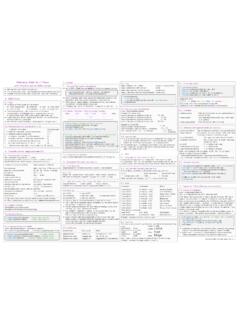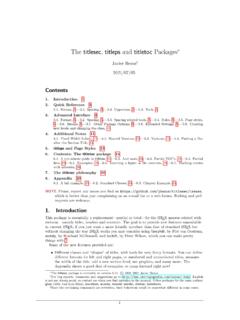Transcription of The beamer class - CTAN
1 The beamer class User Guide for version \begin{frame}. \frametitle{There Is No Largest Prime Number}. \framesubtitle{The proof uses \textit{reductio ad absurdum}.}. \begin{theorem}. There is no largest prime number. \end{theorem}. \begin{proof}. \begin{enumerate}. \item<1-| alert@1> Suppose $p$ were the largest prime number. \item<2-> Let $q$ be the product of the first $p$ numbers. \item<3-> Then $q+1$ is not divisible by any of them. \item<1-> Thus $q+1$ is also prime and greater than $p$.\qedhere \end{enumerate}. \end{proof}. \end{frame}. Results There Is No Largest Prime Number There Is No Largest Prime Number The proof uses reductio ad absurdum. The proof uses reductio ad absurdum. Theorem Theorem There is no largest prime number. There is no largest prime number.
2 Proof. Proof. 1 Suppose p were the largest prime number. 1 Suppose p were the largest prime number. 2 Let q be the product of the first p numbers. 2 Let q be the product of the first p numbers. 3 Then q + 1 is not divisible by any of them. 3 Then q + 1 is not divisible by any of them. 4 Thus q + 1 is also prime and greater than p. 4 Thus q + 1 is also prime and greater than p. 1. F r alle, die die Sch nheit von Wissenschaft anderen zeigen wollen. Copyright 2003 2007 by Till Tantau Copyright 2010,2011 by Joseph Wright and Vedran Mileti . Copyright 2016,2017 by Joseph Wright Permission is granted to copy, distribute and/or modify the documentation under the terms of the gnu Free Documentation License, Version or any later version published by the Free Software Foundation; with no Invariant Sections, no Front-Cover Texts, and no Back-Cover Texts.
3 A copy of the license is included in the section entitled gnu Free Documentation License. Permission is granted to copy, distribute and/or modify the code of the package under the terms of the gnu General Public License, Version 2 or any later version published by the Free Software Foundation. A copy of the license is included in the section entitled gnu General Public License. Permission is also granted to distribute and/or modify both the documentation and the code under the conditions of the LaTeX Project Public License, either version of this license or (at your option) any later version. A. copy of the license is included in the section entitled LATEX Project Public License. 2. The beamer class User Guide for version Till Tantau, Joseph Wright, Vedran Mileti.
4 May 26, 2021. Contents 1 Introduction 9. Main Features .. 9. History .. 9. Acknowledgments .. 10. How to Read this User's Guide .. 10. Getting Help .. 12. I Getting Started 13. 2 Installation 14. Versions and Dependencies .. 14. Installation of Pre-bundled Packages .. 14. TEX Live and MacTEX .. 14. MiKTEX and proTEXt .. 14. Debian and Ubuntu .. 14. Fedora .. 14. Installation in a texmf Tree .. 15. Updating the Installation .. 15. Testing the Installation .. 15. Compatibility with Other Packages and Classes .. 16. 3 Tutorial: Euclid's Presentation 21. Problem Statement .. 21. Solution Template .. 21. Title Material .. 21. The Title Page Frame .. 22. Creating the Presentation PDF File .. 22. The Table of Contents .. 22. Sections and Subsections .. 22. Creating a Simple Frame.
5 23. Creating Simple Overlays .. 23. Using Overlay Specifications .. 24. Structuring a Frame .. 25. Adding References .. 26. Verbatim Text .. 26. Changing the Way Things Look I: Theming .. 28. Changing the Way Things Look II: Colors and Fonts .. 28. 3. 4 Workflow For Creating a beamer Presentation 29. Step One: Setup the Files .. 29. Step Two: Structure Your Presentation .. 29. Step Three: Creating a PDF or PostScript File .. 30. Creating PDF .. 30. Creating PostScript .. 30. Ways of Improving Compilation Speed .. 31. Step Four: Create Frames .. 31. Step Five: Test Your Presentation .. 31. Step Six: Create a Handout .. 31. Creating the Handout .. 31. Printing the Handout .. 32. 5 Guidelines for Creating Presentations 33. Structuring a Presentation .. 33. Know the Time Constraints.
6 33. Global Structure .. 33. Frame Structure .. 35. Interactive Elements .. 37. Using Graphics .. 37. Using Animations and Transitions .. 38. Choosing Appropriate Themes .. 38. Choosing Appropriate Colors .. 38. Choosing Appropriate Fonts and Font Attributes .. 39. Font Size .. 39. Font Families .. 40. Font Shapes: Italics and Small Capitals .. 41. Font Weight .. 42. 6 Solution Templates 43. 7 Licenses and Copyright 44. Which License Applies? .. 44. The GNU General Public License, Version 2 .. 44. Preamble .. 44. Terms and Conditions For Copying, Distribution and Modification .. 45. No Warranty .. 47. The GNU Free Documentation License, Version , 3 November 2008 .. 47. Preamble .. 47. Applicability and definitions .. 48. Verbatim Copying .. 49. Copying in Quantity.
7 49. Modifications .. 49. Combining Documents .. 50. Collection of Documents .. 51. Aggregating with Independent Works .. 51. Translation .. 51. Termination .. 51. Future Revisions of this License .. 52. Relicensing .. 52. Addendum: How to use this License for your documents .. 52. The LATEX Project Public License .. 53. Preamble .. 53. Definitions .. 53. Conditions on Distribution and Modification .. 54. 4. No Warranty .. 55. Maintenance of The Work .. 55. Whether and How to Distribute Works under This License .. 56. Choosing This License or Another License .. 56. A Recommendation on Modification Without Distribution .. 56. How to Use This License .. 57. Derived Works That Are Not Replacements .. 57. Important Recommendations .. 57. II Building a Presentation 58.
8 8 Creating Frames 59. The Frame Environment .. 59. Components of a Frame .. 64. The Headline and Footline .. 64. The Sidebars .. 68. Navigation Bars .. 69. The Navigation Symbols .. 73. The Logo .. 74. The Frame Title .. 74. The Background .. 76. Frame and Margin Sizes .. 77. Restricting the Slides of a Frame .. 78. 9 Creating Overlays 80. The Pause Commands .. 80. The General Concept of Overlay Specifications .. 81. Commands with Overlay Specifications .. 81. Environments with Overlay Specifications .. 85. Dynamically Changing Text or Images .. 86. Advanced Overlay Specifications .. 87. Making Commands and Environments Overlay Specification-Aware .. 87. Mode Specifications .. 89. Action Specifications .. 90. Incremental Specifications .. 91. 10 Structuring a Presentation: The Static Global Structure 94.
9 Adding a Title Page .. 94. Adding Sections and Subsections .. 96. Adding Parts .. 99. Splitting a Course Into Lectures .. 100. Adding a Table of Contents .. 101. Adding a Bibliography .. 104. Adding an Appendix .. 105. 11 Structuring a Presentation: The Interactive Global Structure 107. Adding Hyperlinks and Buttons .. 107. Repeating a Frame at a Later Point .. 110. Adding Anticipated Zooming .. 111. 5. 12 Structuring a Presentation: The Local Structure 113. Itemizations, Enumerations, and Descriptions .. 113. Highlighting .. 118. Block Environments .. 119. Theorem Environments .. 121. Framed and Boxed Text .. 125. Figures and Tables .. 128. Splitting a Frame into Multiple Columns .. 129. Positioning Text and Graphics Absolutely .. 130. Verbatim and Fragile Text.
10 130.. 131. , Quotations, Quotes .. 131.. 132. 13 Graphics 134. Including External Graphic Files Versus Inlines Graphics .. 134. Including Graphic Files Ending .eps or .ps .. 135. Including Graphic Files Ending .pdf, .jpg, .jpeg or .png .. 135. Including Graphic Files Ending .mps .. 135. Including Graphic Files Ending .mmp .. 136. 14 Animations, Sounds, and Slide Transitions 137. Animations .. 137. Including External Animation Files .. 137. Animations Created by Showing Slides in Rapid Succession .. 139. Including External Animations Residing in Multiple Image Files .. 141. Sounds .. 142. Slide Transitions .. 144. III Changing the Way Things Look 147. 15 Themes 148. Five Flavors of Themes .. 148. Presentation Themes without Navigation Bars .. 149. Presentation Themes with a Tree-Like Navigation Bar.









